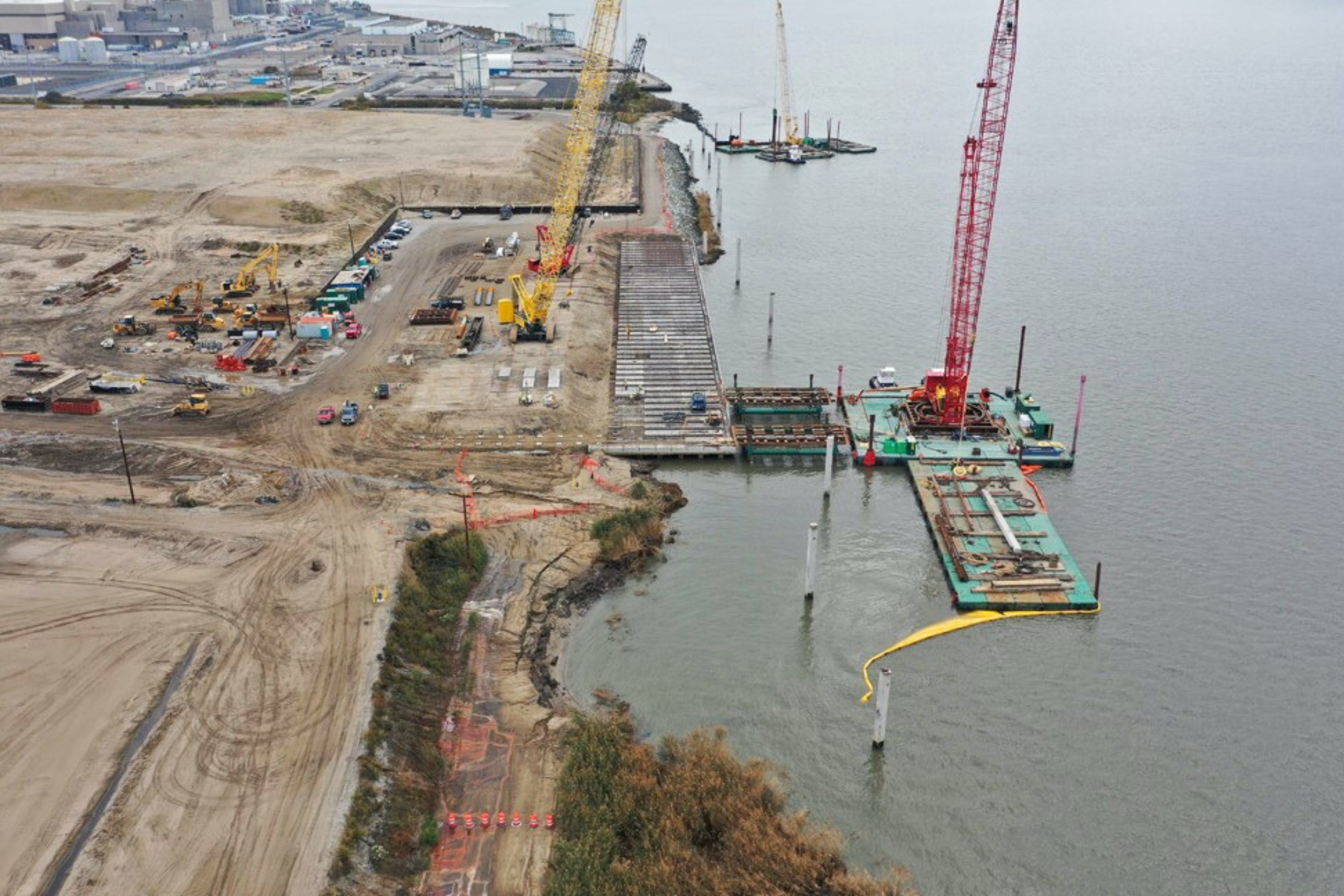Photo credit: NJ Spotlight News (2022), NJ Wind Port Under Construction
By Jessica Parineet
In support of the state’s goals, Governor Murphy’s administration has set an ambitious target of 11,000 megawatts (MW) of installed offshore wind capacity in New Jersey by 2040[1]. Last fall, two offshore wind contracts, Ocean Wind I and Ocean Wind II, were cancelled by the developer Ørsted due to financial and logistical constraints, including inflationary pressures, creating some setbacks in New Jersey’s trajectory to net zero emissions[2]. These projects accounted for 2,248 MW total of potential capacity, and Ocean Wind I was set to be the first operational wind farm in the state. Nevertheless, solicitations have continued as scheduled[3], and three separate offshore wind projects currently hold contracts totaling around 5,252 MW of capacity, which could power nearly 2,500,000 homes[4] [5].
Offshore wind has the potential to contribute to the state’s decarbonization goals while generating approximately 20,000 new jobs for the state by 2030, but exactly how these economic benefits will be distributed remains to be seen[6]. New Jersey policymakers and regulators have an opportunity to address historic disparities in access to high-quality green jobs during the implementation process. Women and people of color have often been excluded from this sector; while women represent half of the labor market in New Jersey, they only account for around 17 to 28 percent of jobs in green industries. Similarly, while Black workers account for 16 percent of the labor force, they only account for nine to 10 percent of green jobs in New Jersey[7]. Though there is much work to be done, there are important strides that relevant institutions have taken to effectively maximize the benefits that this new industry could deliver to marginalized communities.
In 2020, the Governor announced a plan to develop the New Jersey Wind Port, which is a first-of-its-kind facility that provides space for marshalling and manufacturing activities for offshore wind turbines and injects much needed investment into the economically distressed Salem County[8]. The construction company chosen for the project entered a Project Labor Agreement (PLA) that requires monitoring and public reporting on diversity and equity goals included in the agreement in addition to a commitment to hire local union workers for the nearly 1,500 jobs that will be created[9]. The goals include compliance with explicit targets for hiring of women and minority workers and a requirement to expand access to relevant apprenticeship programs[10].
Another important step has been the development of programs administered through the NJ Economic Development Authority (NJEDA) to advance equitable workforce development initiatives in the state. Notably, in 2022, the NJEDA entered an agreement with the Salem County Vocational Technical School to provide $200,000 in funding to expand training programs for offshore wind component manufacturing. This agreement develops a necessary pipeline of skilled workers in New Jersey while creating a pathway for high school and postsecondary students to enter a high-paying job in a green industry without significant barriers to entry[11]. Last year, the NJEDA awarded $3.7 million in grant funding to five different organizations through the Offshore Wind Workforce and Skills Development Grant Challenge. The awards were intended to fund programs that address the need for workforce development that focuses on overburdened communities and provide wraparound services, like transportation, to decrease barriers to participation in the offshore wind workforce[12].
These are just a few examples of the investments and programs that have been incorporating equity considerations in the early stages of this new industry. Developers have also been incentivized to invest in and create programs that are advancing equitable hiring opportunities and community benefits[13][14][15]. Continued monitoring of the results of these programs will be key to ensuring the equitable distribution of benefits of this new industry, and identifying areas where additional legislation or enhanced approaches would complement existing action.
Jessica Parineet is a Research Assistant with the New Jersey State Policy Lab and a graduate student in the Master of Public Policy program at the Bloustein School of Planning and Public Policy.
References:
[1] New Jersey Department of Environmental Protection. (n.d.). About Offshore Wind. dep.nj.gov. https://dep.nj.gov/offshorewind/about/
[2] Ørsted. (2023, October 31). Ørsted ceases development of Ocean Wind 1 and Ocean Wind 2 and takes final investment decision on Revolution Wind. us.orsted.com. https://us.orsted.com/news-archive/2023/10/orsted-ceases-development-of-ocean-wind-1-and-ocean-wind-2#:~:text=The%20decision%20to%20cease%20development%20of%20Ocean%20Wind,energy%20industry%2C%20including%20offshore%20wind%20and%20land-based%20technologies.
[3] New Jersey Board of Public Utilities. (2022). New Jersey Offshore Wind Program. https://njoffshorewind.com/
[4] New Jersey Department of Environmental Protection. (n.d.). Offshore Wind Project Areas: Atlantic Shores. dep.nj.gov. https://dep.nj.gov/offshorewind/projects/#atlantic-shores
[5] State of New Jersey Board of Public Utilities. (2024, January 24). NJBPU approves over 3,700 MW of offshore wind capacity in combined award. www.nj.gov. https://www.nj.gov/bpu/newsroom/2023/approved/20240124.html
[6] New Jersey’s Offshore Wind Workforce Assessment Through 2035. (2022). New Jersey Economic Development Authority. https://www.njeda.gov/wp-content/uploads/2022/09/2022-NewJersey-OSW-Workforce-Assessment-Report.pdf
[7] Green Jobs for a Sustainable Future Leveraging Our Strengths to Grow an Inclusive Green Economy. (2022). NJ Council on the Green Economy. https://www.nj.gov/governor/climateaction/documents/CGE%20Roadmap.pdf
[8] Governor Murphy announces plan to develop the New Jersey Wind Port: First Purpose-Built Offshore Wind Port in the U.S. (2020, June 16). www.nj.gov. https://www.nj.gov/governor/news/news/562020/20200616a.shtml
[9] New Jersey Wind Port. (2021, December 15). Fast Facts About NJWP. nj.gov. https://nj.gov/windport/about/pdf/20211215OSWFastFacts.pdf
[10] Overview of required Project Labor Agreement provisions for ATRISK Construction Management Services for the New Jersey Wind Port Project. (2021, April 27). www.nj.gov. https://www.nj.gov/windport/docs/20210427_EXHIBITJ-PLA1.pdf
[11] NJEDA Board approves support for Salem County Offshore Wind job training programs. (2022, April 14). NJEDA. https://www.njeda.gov/njeda-board-approves-support-for-salem-county-offshore-wind-job-training-programs/
[12] Nearly $4M in grants to support offshore wind workforce training approved by NJEDA Board. (2023, June 21). NJEDA. https://www.njeda.gov/nearly-4m-in-grants-to-support-offshore-wind-workforce-training-approved-by-njeda-board/
[13] https://atlanticshoreswind.com/project1/
[14] https://invenergy.com/news/leading-light-wind-an-american-led-offshore-wind-project-awarded-contract-by-state-of-new-jersey-ushers-in-new-era-for-domestic-clean-energy-transition

